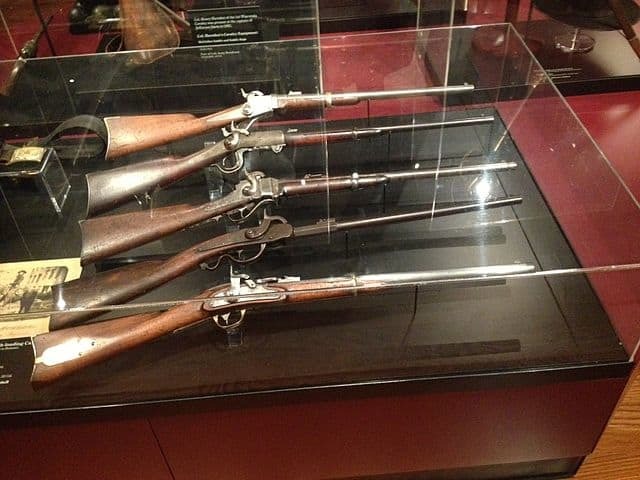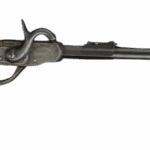
The Union Army Arsenal
The American Civil War, which spanned from 1861 to 1865, was an epoch of extraordinary technological growth. One area that bore witness to these advancements was firearms technology. The Union Army, in particular, was outfitted with a diverse and innovative array of firearms. This revised article delves into the major firearms employed by Union soldiers, the factories responsible for their production, and their impact on the Civil War.
The Springfield Model 1861
The Springfield Model 1861 rifle-musket was the primary firearm and backbone of the Union Army arsenal. This .58 caliber weapon, renowned for its accuracy up to 500 yards, was manufactured at the Springfield Armory in Massachusetts. With nearly 1 million units made during the war, it was the workhorse of the Union infantry.
The Springfield Model 1861 was a significant improvement over previous muskets due to its rifled barrel. Earlier muskets had smoothbore barrels, meaning they lacked grooves that caused the bullet to spin and consequently, provided a more accurate trajectory. This made the Springfield Model 1861 more accurate and longer-ranging than its predecessors.
Its impact was most keenly felt in battles such as Gettysburg, where precise and effective rifle fire played a critical role in the Union's victory. One notable user was Joshua Lawrence Chamberlain, a Union colonel, who later became a major general, and used the Springfield 1861 during the Battle of Gettysburg, leading his 20th Maine regiment to hold the Union's left flank.
The Colt 1860 Army Revolver
Produced by Colt's Patent Fire Arms Manufacturing Company in Hartford, Connecticut, the Colt 1860 Army Revolver was a .44 caliber, six-shot, single-action percussion revolver. It was a popular choice among Union soldiers due to its ease of use, light weight, and formidable firepower. Approximately 200,000 units were produced during the war making it the most common revolver in the Union Army arsenal.
This was a percussion revolver, which was an advancement over older flintlock pistols. Flintlock firearms could be unreliable, as they were susceptible to weather and could misfire. In contrast, percussion caps were more reliable and allowed for faster reloading. The Colt 1860 also represented an improvement in terms of portability and ease of use, essential factors for cavalry and infantry.
This revolver was famously used by General George Armstrong Custer, contributing to Union victories in battles such as Gettysburg and the Third Battle of Winchester.
The Spencer Repeating Rifle
The Spencer Repeating Rifle, manufactured by the Spencer Repeating Rifle Company in Boston, was a .52 caliber, lever-action rifle capable of firing seven rounds before reloading. Its rapid-fire capability granted Union forces a significant advantage in many battles, providing a great addition to the Union Army arsenal.
This weapon was groundbreaking due to its repeating mechanism, allowing soldiers to fire multiple rounds before needing to reload. This was a significant departure from the single-shot firearms commonly used at the time. With its seven-round capacity, the Spencer Repeating Rifle allowed Union soldiers to maintain a higher rate of fire, providing a distinct advantage on the battlefield.
President Lincoln famously test-fired a Spencer Rifle on the White House grounds, an event that played a significant role in its adoption by the Union army. About 200,000 units were produced during the war.
The Sharps Rifle
The Sharps Rifle, a .52 caliber breech-loading rifle, was renowned for its accuracy and long range. Manufactured by the Sharps Rifle Manufacturing Company in Hartford, Connecticut, the Sharps Rifle saw extensive use by Union troops. Approximately 80,000 units were produced during the war.
The Sharps Rifle was a breech-loading rifle, representing another significant advancement in firearm technology. Unlike muzzle-loading firearms, which were loaded from the front of the barrel, breech-loaders were loaded from the back. This allowed for quicker reloading and enabled the soldier to reload while remaining in a prone position, offering a significant advantage in terms of safety and firing rate.
Hiram Berdan, who led the 1st and 2nd U.S. Sharpshooters, was one of the most famous users of the Sharps Rifle. His units significantly contributed to Union victories in battles like Gettysburg and the Siege of Yorktown.
Henry Rifle
The Henry Rifle, a .44 caliber, lever-action rifle with a 16-round magazine, was another advanced firearm used by the Union forces. It was produced by the New Haven Arms Company in Connecticut and, although it was never officially part of the Union Army arsenal, it was highly favored by Union soldiers due to its reliability and rapid-fire capability. There are accounts of soldiers families banding together to purchase these for the men who went to war.
The Henry Rifle took the concept of the repeating rifle a step further with its 16-round magazine. It combined the fast reloading capability of a breech-loader with the rapid-fire ability of a repeater, making it an effective firearm for both infantry and cavalry use.
Enfield P53
The Enfield P53 was a British-made .577 caliber rifle-musket. Despite being a foreign weapon, it saw significant use by the Union forces, who imported it and added it to the Union Army arsenal due to its accuracy and reliability. Many units, especially those early in the war, were equipped with the P53.
The Enfield P53 represented a standard in reliable, accurate rifled muskets and was widely used by Union forces. It underscored the global progress in rifling technology and mass production.
Burnside Rifle
Named after its inventor, Ambrose Burnside, later a Union general, the Burnside Rifle was a .54 caliber, breech-loading carbine. It was designed for cavalry use and known for its unique, cone-shaped cartridge.
The Burnside Rifle was a breech-loading carbine, utilized a unique, cone-shaped cartridge. This cartridge design made the weapon more resistant to adverse weather conditions, making it an improvement over previous breech-loading designs.
Burnside Rifle Company in Rhode Island produced around 55,000 units during the war, making it a significant part of the Union Army Arsenal.
Hall Rifle
The Hall Rifle, a .52 or .58 caliber breech-loading rifle, was another firearm that saw use by Union forces. Although it was considered somewhat outdated by the time of the Civil War, it was still part of the Union Army arsenal due to its ease of loading and firing.
Whitworth Rifle
The Whitworth Rifle, a British-made firearm, was used by both sides during the Civil War but saw significant use by Union sharpshooters due to its exceptional accuracy over long distances. It was a .45 caliber, single-shot, muzzle-loading rifle.
The Whitworth Rifle showcased advancements in precision manufacturing and rifling. Its hexagonal bore and mechanically fitting bullets allowed for a higher degree of accuracy at longer distances than other rifles of the time, making it highly valued by sharpshooters.
Lorenz Rifle
The Lorenz Rifle was an Austrian .54 or .58 caliber rifle that saw significant use by Union forces due to a shortage of domestic arms early in the war. It was not as accurate as other rifles but was reliable and robust member of the Union Army arsenal, making it a practical choice for the infantry.
The Lorenz Rifle wasn't a major advancement technologically but highlighted the importance of reliable, practical, and robust designs for infantry firearms. It also underscored the global nature of arms development and trade during this period.
The Impact of These Firearms on the War
Each of these firearms played a unique role in shaping the Civil War's outcome. The wide variety of weapons, combined with the North's industrial strength, gave the Union forces a distinct advantage. From the Springfield Model 1861's widespread usage and precision, to the Spencer Rifle's rapid-fire capabilities, to the accurate and long-ranging Sharps and Whitworth rifles, Union firearms technology played a critical role in their eventual victory.
The firearms used during the Civil War represent the transition from the era of smoothbore, muzzle-loading muskets to the age of rifled, breech-loading, and repeating firearms. The advancements in technology that these weapons demonstrated would have a profound influence on warfare and lay the groundwork for future developments in firearm technology.
The technological advancements witnessed during the Civil War marked a shift in warfare, leading to more modern, brutal forms of combat seen in later conflicts. The Union Army's diverse arsenal and the factories that supplied it remain significant chapters in the history of American warfare.
To read more about weapons of the Union Army arsenal, check out some of these excellent books:




If you know of any forums or sites that should be referenced on this listing, please let us know here.



